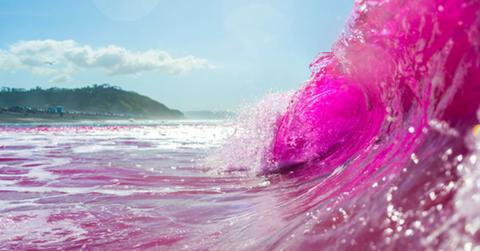Part of the Pacific Ocean Has Been Turned Pink, Because Science Is Amazing
Published Jan. 27 2023, 1:17 p.m. ET

Pink waves at Torrey Pines State Beach
Scientists are taking a note from Elle Woods, by thinking pink.
A study, which is taking place at a San Diego beach, is temporarily turning part of the Pacific Ocean hot pink. The experiment blew La Jolla, Calif. residents and beachgoers away with the gorgeous hues along their coastlines — and not to mention — the results will give experts a better idea of how freshwater interacts with dense, salty seawater.
Aside from providing incredible photo opportunities, the experiment is going to leave a serious mark in the world of marine biology.
“I'm excited because this research hasn't been done before and it's a really unique experiment,” stated Scripps coastal oceanographer and lead study author, Sarah Giddings. “We're bringing together a lot of different people with different expertise, such that I think it's going to have some really great results and impacts."
"We will combine results from this experiment with an older field study and computer models that will allow us to make progress on understanding how these plumes spread," she continued.
So, why are scientists turning the ocean pink? It isn't just a fashion statement.
Why is the Pacific Ocean pink?
San Diego's coastlines will boast a deep pink hue through February — so you have a little time to see it.
The experiment is called Plumes in Nearshore Conditions, or PiNC. It's being led by UC San Diego’s Scripps Institution of Oceanography and the University of Washington, and funded by the National Science Foundation. It's examining how small amounts of freshwater interact with ocean water, specifically within the estuary and waters at Torrey Pines State Beach's Los Peñasquitos Lagoon.
While it's already known that freshwater often brings sediment and sometimes even contaminants to ocean waters near the shore, it's unknown how it reacts to ocean water where the surf breaks. By tracking the eco-friendly dye with drones, sensors in the sand, moorings along the seafloor, and even a jet ski with a special device that measures the dye's fluorescence, scientists will get more insight into how both types of water interact together, and how things like pollutants and sediment spread.
Throughout the experiment, there will be three dye releases total — the first took place on Jan. 20, and the rest will be throughout January and February 2023. So if you see the ocean looking a little unusual in the San Diego area, know that it's in the name of science.
This isn't to be confused with Red Tide.
As we said, the pink colors you might see along La Jolla's coastlines are completely harmless to both people and wildliife. However, if you happen to see red hues in the water, you'd be better off staying away.
California has also been home to some nasty red tides, particularly in the Golden State's Lake Merritt. Red tides are caused by algal blooms that can kill fish and pets, while making people sick.
Harmful algal blooms are caused by a number of factors, including warming temperatures, agricultural runoff, and more. That said, it's always best to keep your distance from any freshwater that might look suspicious to you.